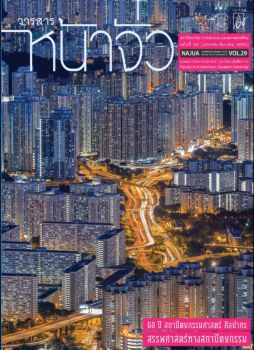หมู่บ้านและเรือนพวน บ้านกลาง ตำบลปากตม อำเภอเชียงคาน จังหวัดเลย
Keywords:
ไทพวน, เรือน, หมู่บ้าน, Tai Phaun, Vernacular House, VillageAbstract
บทความนี้นำเสนอการปรับตัวและการเปลี่ยนแปลงแบบเรือนพักอาศัยของชาวพวนบ้านกลาง ตำบลปากตม อำเภอเชียงคาน จังหวัดเลย โดยพิจารณาจากสภาพแวดล้อมทางกายภาพ เรือน พักอาศัย และปัจจัยเกี่ยวเนื่อง ได้ผลสรุปคือ ชาวบ้านกลางเป็นชาวพวนที่อพยพลงมาจากเมืองหลวงพระบางในคราวศึกฮ่อ มาตั้งถิ่นฐานอยูริ่มลำน้ำเลยฝั่งทิศตะวันตก ในคราวแรกตั้งหมู่บ้านมีต้นมะขาม เป็นใจบ้านหรือมิ่งบ้าน เรือนในยุคแรกมีแบบแผนคล้ายกันกับเรือนเซียที่โครงสร้างส่วนใหญ่เป็นไม้ไผ่ หลังคามุงหญ้าแบบเรือนในหลวงพระบาง ต่อมาราวหลัง พ.ศ. 2480 เป็นต้นมา เริ่มมีการเปลี่ยนแปลง แบบเรือนเป็นเรือนไม้จริงมุงหลังคาด้วยกระเบื้องซีเมนต์ หลังคาทรงปั้นหยา มีทั้งที่หักฉากเป็นเรือนมุข และสองมุขแบบตัวยู ทั้งเทคนิคและวัสดุคือกระเบื้องซีเมนต์เป็นสิ่งที่ช่างปลูกเรือนในหมู่บ้านนำเข้ามา ซึ่งเป็นอิทธิพลของกระแสความนิยมที่เกิดจากอาคารทางราชการและเรือนแถวยุคแรกๆในจังหวัดเลย ลักษณะสำคัญของแบบเรือนนี้ยังคงแบบแผนการลำดับภายในเรือนตามแบบเรือนเซีย แต่ปรับส่วนเซียลดลงตามส่วนที่มุขยื่นออกมาแทน ใต้ถุนเรือนตํ่า นิยมบานประตูเฟี้ยม นอกจากนั้นยังมีเรือนที่ทำ แบบเรือนแถวคือหันส่วนระเบียงหรือเซียหาทางสัญจร ทำประตูเฟื้ยมยาวเกือบตลอดด้านหน้า เมื่อทางรถไฟมาถึงขอนแก่นและเส้นทางคมนาคมเชื่อมต่อกันมากขึ้น มีการขนส่งสังกะสีมุงหลังคาเข้ามา ในจังหวัดเลย เรือนเริ่มเปลี่ยนมามุงสังกะสี ยกใต้ถุนสูง เรือนแบบนี้ต่อมานิยมก่อผนังกั้นพื้นที่ใต้ถุน เรือนเพื่อใช้ประโยชน์สำหรับอยู่อาศัย เมื่อมีการสร้างสะพานข้ามลำน้ำเลยในพ.ศ. 2537 ที่บ้านกลาง การติดต่อค้าขายกับภายนอกมีมากขึ้น เรือนแบบคอนกรีตเสริมเหล็กชั้นเดียวมุงกระเบื้องลอนใยหิน ก็เป็นที่นิยม มักยกพื้นสูงเล็กน้อยสำหรับเก็บสิ่งของเครื่องใช้ เรือนเก่าแบบหลังคาซีเมนต์ก็เริ่มถูกรื้อ ถอนลงเพื่อสร้างเรือนแบบใหม่อย่างต่อเนื่องจนถึงปัจจุบัน
The village and Vernacular House of the Tai Phuan Ban Klang, Amphor Chiangkan, Loei Province
Songyot Weerataweemat, Ph.D.
Assistant Professor, Faculty of Architecture, Khonkaen University
This article investigates the adaptation and change of the vernacular house of the Tai Phaun at Ban Klang village, Amphor Chiangkan, Loe Province, according to social, economic and related factors. The Phaun of Ban Klang were those migrated from Laung Phrabang, Lao PDR since the invasion of the Hao during the late 18th century. They settled at the west bank of Loe River, 4 kilometers south of the Mekhong. A tamarind tree was assumed to be a sacred center of the village. The initial pattern of their house was similar to the old Laung Phrabang “Hean Sia” house (Verandah house) style. Almost of its structure was built of bamboo with thatch roof. After the decade of 1937 new materials and house style were introduced to the village by villager house builders, who had some experiences as employee in the construction projects in Cheangkan and Loe Cities. A hip roof with cement tile of timber house was adopted to replace the original Hean Sia house. The L-shaped and U-shaped roof plans were the prominent form of the houses. However, the traditional arrangement of the house plan was still preserved. The verandah (Sia) was shorten while folding door usually was the main entrance door. Another style of the house was that influenced by the shop or row house. Its verandah with folding door was put adjacent to thoroughfare. After the arrival of the railway and transportation improvement in northeast Thailand, galvanized metal sheet was the new material that affected the proportion of the house. The ground floor space was made higher and soon later the space was enclosed for living function. After the bridge across the Loe River at Ban Klang was completed in 1994, transportation was made much more easier than before. One story reinforced concrete structure house has been gradually popular. A lot of older style houses have been demolished.





